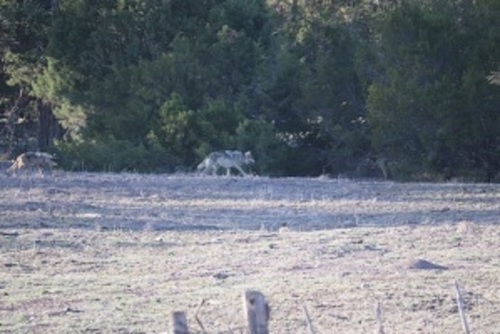The Chronicles Of Grant County
Mexican Wolves
Part Three
Statistics Of Livestock Depredations In Catron County
 Mexican wolves in Catron County, New Mexico. (Photograph was provided courtesy of Jess Carey, Catron County Wildlife Investigator.)
Mexican wolves in Catron County, New Mexico. (Photograph was provided courtesy of Jess Carey, Catron County Wildlife Investigator.)
This news column is part of a series of reports to the people of Grant County and beyond on the re-introduction of wolves to New Mexico and Arizona. The news columns will include details on many aspects of this program – from those who support the re-introduction of the wolves to those affected by the program. Views will be included from wildlife organizations, ranchers, governmental officials, among others. Individual news columns will focus on specific aspects of these efforts.
Part Three details the statistics of depredation of livestock in Catron County.
"Catron County is home to more than 95% of the wolves in the state," stated Jess Carey, Catron County Wildlife Investigator. The activities in Catron County, located just north of Grant County, directly impact people in Grant County as wolves do not recognize county boundaries.
Wolves are not the only animals that kill livestock. According to Mr. Carey, among other animals involved in depredation of livestock in Catron County are bears, lions, and wild dogs. In addition, depredations can be caused by humans as well as occur in nature.
The statistics and the details about the depredations in Catron County included in this news column are from reports issued by Mr. Carey.
In 2017, there were 42 complaints of livestock depredations in Catron County. Of that number, Mr. Carey indicated that 19 were confirmed caused by wolves, 2 were probable wolf depredations, 6 were confirmed caused by coyotes, and 3 were confirmed caused by bears. Two depredations were caused by humans – one shot by a human and one depredation by motor vehicle impact. Ten depredations had unknown causes.
In 2018, Catron County recorded 115 complaints of livestock depredations. Mr. Carey indicated that of that number, 74 were confirmed caused by wolves, 7 were probable wolf depredations, 7 were confirmed caused by coyotes, 10 were confirmed caused by bears, and 2 were confirmed caused by wild dogs. Five depredations were ones in nature. Ten depredations were caused by unknown circumstances.
In 2019, Mr. Carey indicated that Catron County received 155 complaints dealing with depredations of livestock. Of that number, Mr. Carey reported that 136 were confirmed caused by wolves, 7 were probable wolf depredations, 2 were confirmed caused by coyotes, and 3 were confirmed caused by bears. Seven depredations were due to unknown causes.
In 2020, there were 167 complaints registered with Catron County for livestock depredations. Mr. Carey indicated that of that number, 129 were confirmed caused by wolves, 2 were probable wolf depredations, 2 were confirmed caused by coyotes, one was confirmed caused by a bear, and one was confirmed caused by a lion. Three depredations were caused by humans through motor vehicle impacts. One depredation was one in nature. Twenty-eight depredations were caused by unknown circumstances.
Through the latter part of May of 2021, there were 54 complaints of depredations in Catron County thus far during 2021. Of that number, 40 were confirmed caused by wolves, 2 were probable wolf depredations, and 4 were confirmed caused by coyotes. Eight depredations were caused by unknown circumstances.
Do you have questions about communities in Grant County?
A street name? A building?
Your questions may be used in a future news column.
Contact Richard McDonough at chroniclesofgrantcounty@mail.com.
If your email does not go through, please contact editor@grantcountybeat.com.
© 2021 Richard McDonough